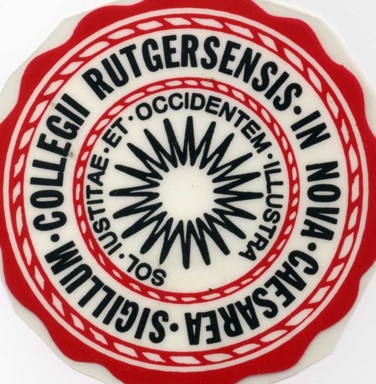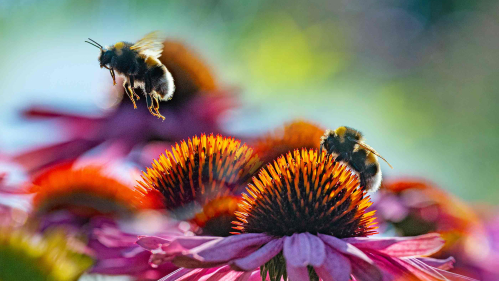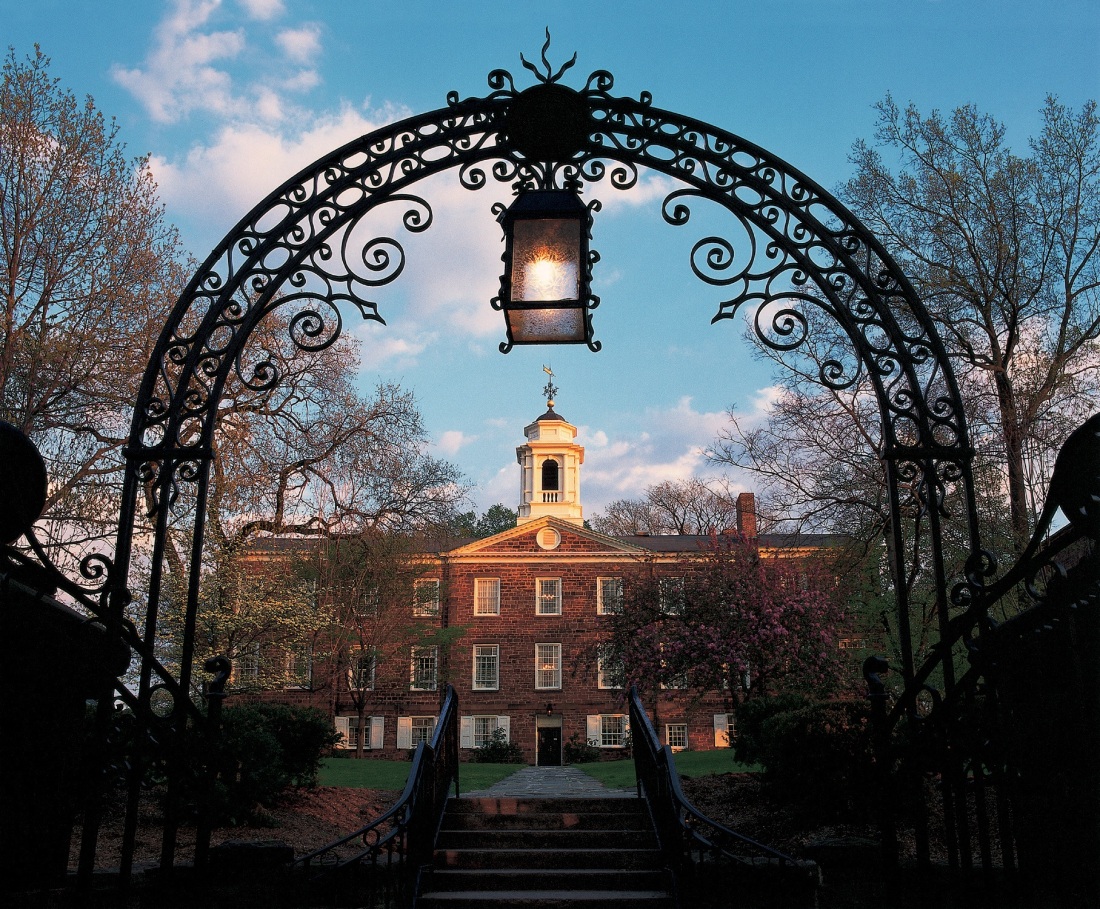
Our Great Seal, which we dearly miss.
5.16.24 [Just today from the institution]
Kitta Macpherson
kitta.macpherson@rutgers.edu

Bunkers and Hotels for Bees | Rutgers University
Rutgers scientists are experimenting with new kinds of habitats that could help maintain the population of bees — key pollinators for the food supply.
Rutgers scientists conduct experiment using novel structures to aid the proliferation of wild, native bees
Rutgers ecologist Kimberly Russell is the lead researcher on an unusual project that, if successful, will soon allow her to share the idea throughout New Jersey and beyond: the installation of “bee bunkers” and “bee hotels” in spots around New York City to provide nourishment and shelter for at-risk native bee populations.
Russell is an associate professor and the undergraduate program director in the Department of Ecology, Evolution and Natural Resources in the Rutgers School of Environmental and Biological Sciences. A community ecologist, she focuses on conserving the biodiversity of arthropods – invertebrates belonging to the phylum Arthropoda, a group that includes bees, spiders and crustaceans.
She discussed the purpose and importance of the Pollinator Port Project, which is sponsored by the Ittleson Foundation, and is a collaboration between the New York City Department of Transportation, the Horticultural Society of New York and Rutgers University.
__________________________
Where did the concept of bee bunkers and bee hotels come from? Do they work?
The structures we are calling bee bunkers are the truly innovative part of the project. A former student of mine, Nina Fedoryka, a George H. Cook Scholar, coined the phrase. I think it’s brilliant.
Most people don’t realize that the majority of native bees nest in the ground — nearly three-quarters of the species. Ground-nesting bees are hardest hit in urban areas where bare ground is scarce.
We designed a habitat that, based on what is known about nesting preferences, would appeal to the widest diversity of bees. Bee bunkers provide protected soil into which female bees build their nests and lay their eggs. We submerge the bunkers into the soil of an extra-large planter, so that flowering plants that provide food for the bees could surround and protect it.

Rutgers ecologist Kimberly Russell is leading a project to install bee bunkers (the two small barrels shown) and bee hotels (the wooden structure at the top of the pole) in spots across New York City. If successful, she hopes to bring the project to cities in New Jersey and other states. The bunkers and hotels are designed to provide nesting areas to encourage the stability of the native bee population.
Kimberly Russell
Honestly, we don’t know how well the bunkers will work, as there is very little research on it, or even trials similar to ours. We only found one study that tracked the success of human-made soil habitats in an urban setting – in a park in a small city in France. But they had success, so we found that encouraging.
Bee hotels, which look like birdhouses, have been around for quite a while. They will attract a decent proportion of the rest of the bee population that nests in stems and cavities.
Why are native bee populations at risk, and why should that concern the public?
The majority of the plants we enjoy in our gardens and open spaces, as well as many of the plants we depend on for food, require pollination.
Bees are the most abundant and widespread pollinators in the world. We have become unnecessarily dependent on the non-native European honeybee, especially in terms of agriculture.
We have our own native bees that can do the same work if we support them, but they face many threats. Many species are declining in abundance. Caring for bees allows us to care for the plants we need and love.
Doesn’t corralling bees into confined spaces increase the chance of someone being stung?
There are two types of bees in the U.S. that regularly sting humans — the European honeybee and, to a lesser extent, bumblebees. Both live in colonies and sting to protect their extended families. Neither would be interested in bee bunkers or hotels, as they have distinct nesting preferences that require a very different set of characteristics.
No one can fully guarantee that another type of bee won’t sting – all females have stingers, so technically they are capable. But these are very rare events. I have been studying native bees for 20 years and have never been stung by one of my subjects.
Why do you study arthropods? How does your research tie into this project?
As a graduate student, I realized that we know far less about arthropods than we do about vertebrates, despite the fact that we are significantly more reliant on them for survival. I made it my mission to devote my career to understanding the needs of these creatures.
After working with spiders for a number of years, I got involved with a project surveying bee populations at the U.S. Geological Survey’s Patuxent Wildlife Research Center in Maryland. I was always curious about the relationship between bees and plants, so this was my way into considering how those relationships affect extinction risk.
From there, I have been focused on building resilience in wild bee populations by studying ways to develop habitat for them in human-dominated landscapes. This project takes this to an even more urban extreme by trying to supplement and even create habitat in cities for these bees.
As a scientist, what do you hope to learn from this project?
I want to know if we can entice enough native bees to use our bee bunkers to make a real impact.
Little is known about the preferences of ground nesting bees, so this study will provide a real test of what we think we know. I also want to learn how bees navigate around the city — how do they travel from green space to green space? How do they navigate around traffic and buildings? Are they using the street trees as protected flight paths?
One project my lab is working on involves marking bees using safe, biodegradable, colored spots to gain information about their population size and movement. Understanding that movement will help us better place our habitats to provide steppingstones between bigger green spaces.
Are there plans to extend this project to New Jersey and elsewhere?
Yes. Once we see some success with our pilot designs, the idea is to provide the protocols to partners in other cities in New York, New Jersey and elsewhere.
These Pollinator Ports will do the most good in the most naturally impoverished areas for bees, so the focus will be on large cities like Newark and Philadelphia.
But we also want to emphasize that community groups and schools can do this on their own – it is a great way to give the bees a helping hand while educating the public about their importance. This also will help people get in touch with nature, an important component to the mission of the Horticultural Society of New York.
See the full article here .
Comments are invited and will be appreciated, especially if the reader finds any errors which I can correct.

five-ways-keep-your-child-safe-school-shootings
Please help promote STEM in your local schools.
Rutgers-The State University of New Jersey, is a leading national research university and the state’s preeminent, comprehensive public institution of higher education. Rutgers is dedicated to teaching that meets the highest standards of excellence; to conducting research that breaks new ground; and to providing services, solutions, and clinical care that help individuals and the local, national, and global communities where they live.
Founded in 1766, Rutgers teaches across the full educational spectrum: preschool to precollege; undergraduate to graduate; postdoctoral fellowships to residencies; and continuing education for professional and personal advancement.
Rutgers University is a public land-grant research university based in New Brunswick, New Jersey. Chartered in 1766, Rutgers was originally called Queen’s College, and today it is the eighth-oldest university in the United States, the second-oldest in New Jersey (after Princeton University), and one of the nine U.S. colonial colleges that were chartered before the American War of Independence. In 1825, Queen’s College was renamed Rutgers College in honor of Colonel Henry Rutgers, whose substantial gift to the school had stabilized its finances during a period of uncertainty. For most of its existence, Rutgers was a private liberal arts university but it has evolved into a coeducational public research university after being designated The State University of New Jersey by the New Jersey Legislature via laws enacted in 1945 and 1956.
Rutgers has four distinct campuses: Rutgers University–New Brunswick, including grounds in adjacent Piscataway; Rutgers University–Newark; Rutgers University–Camden; and Rutgers Biomedical and Health Sciences. The university has additional facilities elsewhere in the state, including oceanographic research facilities at the New Jersey shore. Rutgers is also a land-grant university, a sea-grant university, and the largest university in the state. Instruction is offered by over 9,000 faculty members in 175 academic departments to over 45,000 undergraduate students and more than 20,000 graduate and professional students.
The university is accredited by the Middle States Association of Colleges and Schools and is a member of the Big Ten Academic Alliance, the Association of American Universities and the Universities Research Association. Over the years, Rutgers has been considered a “Public Ivy”.
Rutgers University became the land-grant college of New Jersey in 1864 under the Morrill Act of 1862, resulting in the establishment of the Rutgers Scientific School, featuring departments of agriculture, engineering, and chemistry. The Rutgers Scientific School would expand over the years to grow into the New Jersey Agricultural Experiment Station (1880) and divide into the College of Engineering (1914) and the College of Agriculture (1921). Rutgers created the New Jersey College for Women in 1918, and the School of Education in 1924.
With the development of graduate education, and the continued expansion of the institution, the collection of schools became Rutgers University in 1924. Rutgers College continued as a liberal arts college within the university. Later, University College (1945) was founded to serve part-time, commuting students and Livingston College (1969) was created by the Rutgers Trustees, ensuring that the interests of ethnically diverse New Jersey students were met.
The newly-designated state university absorbed the University of Newark (1935) in 1946 and then the College of South Jersey and South Jersey Law School, in 1950. These two institutions became Rutgers University–Newark and Rutgers University–Camden, respectively. On September 10, 1970, after much debate, the board of governors voted to admit women into Rutgers College.
In 1970, the newly formed Rutgers Medical School hired major faculty members from other institutions. In 1971, the governor’s office separated Rutgers Medical School from Rutgers University and made it part of New Jersey College of Medicine and Dentistry, and many faculty left the medical school, including the dean of the medical school, Dewitt Stetten, who later became the director of the National Institutes of Health. As a result of the separation of the medical school from Rutgers University, Ph.D. programs that had been started in the medical center were lost, and students had to seek other institutions to finish their degrees. After the dissolution of the University of Medicine and Dentistry in 2013, the medical school again became part of the university.
Before 1982, separate liberal arts faculties existed in the several separate “residential colleges” (Rutgers, Douglass, Livingston, University, and Cook colleges) at Rutgers–New Brunswick.
In 2007, Rutgers New Brunswick, Douglass, Livingston, and University Colleges, along with the Faculty of Arts and Sciences were merged into the new “School of Arts and Sciences” with one set of admissions criteria, curriculum, and graduation requirements. At this time, the liberal arts components of Cook College were absorbed into the School of Arts and Sciences as well, while the other aspects of that college remained, but as the School of Environmental and Biological Sciences. These changes in 2007 ended the 241-year history of Rutgers College as a distinct institution.
In 2013, most of the University of Medicine and Dentistry of New Jersey was integrated with Rutgers University and, along with several existing Rutgers units, was reformed as Rutgers Biomedical and Health Sciences. This merger attached the New Jersey Medical School and Robert Wood Johnson Medical School to Rutgers University.
The university offers more than 100 distinct bachelor, 100 masters, and 80 doctoral and professional degree programs across 175 academic departments, 29 degree-granting schools, and colleges, 16 of which offer graduate programs of study.
It is accredited by the Commission on Higher Education of the Middle States Association of Colleges and Schools (1921), and in 1989, became a member of the Association of American Universities, an organization of the 71 leading research universities in North America. Rutgers–New Brunswick is classified among “R1: Doctoral Universities – Very high research activity”. Rutgers–Newark and Rutgers–Camden are classified by the same organization as “R2: Doctoral Universities – High research activity”.
Under the New Jersey Medical and Health Sciences Education Restructuring Act of 2012, the University of Medicine and Dentistry of New Jersey was dissolved. Most of its schools, including Robert Wood Johnson Medical School, New Jersey Medical School, and New Jersey Dental School, were merged into the new Rutgers Biomedical and Health Sciences, formed in 2013.
The Rutgers Scarlet Knights are members of the Big Ten Conference, a collegiate athletic conference consisting of 14 colleges and universities from the Midwestern and East Coast regions of the United States. The Big Ten Conference is a member of the Bowl Championship Series. Rutgers currently fields 27 intercollegiate sports programs and is a Division I school as sanctioned by the National Collegiate Athletic Association. Rutgers fields thirty teams in NCAA Division I sanctioned sports.
Many members of the faculty have received the highest awards in their fields, including Guggenheim and MacArthur “Genius Award” fellowships, Pulitzer Prize winners, National Medal of Science and National Medal of Technology recipients, a National Endowment for the Arts “Jazz Master,” amongst others. Science, engineering, and medical faculty are members of the four “National Academies”—the National Academy of Sciences, the National Academy of Engineering, the Institute of Medicine, and the National Research Council.
Rutgers is home to the Rutgers University Center for Cognitive Science, also known as RUCCS. This research center hosts researchers in psychology, linguistics, computer science, philosophy, electrical engineering, and anthropology.
It was at Rutgers that Selman Waksman (1888–1973) discovered several antibiotics, including actinomycin, clavacin, streptothricin, grisein, neomycin, fradicin, candicidin, candidin, and others. Waksman, along with graduate student Albert Schatz (1920–2005), discovered streptomycin—a versatile antibiotic that was to be the first applied to cure tuberculosis. For this discovery, Waksman received the Nobel Prize for Medicine in 1952.
Rutgers developed water-soluble sustained release polymers, tetraploids, robotic hands, artificial bovine insemination, and the ceramic tiles for the heat shield on the Space Shuttle. In health-related field, Rutgers has the Environmental & Occupational Health Science Institute (EOHSI).
Rutgers is also home to the RCSB Protein Data bank, “…an information portal to Biological Macromolecular Structures’ cohosted with the San Diego Supercomputer Center. This database is the authoritative research tool for bioinformaticists using protein primary, secondary and tertiary structures worldwide….”
Rutgers is home to the Rutgers Cooperative Research & Extension office, which is run by the Agricultural and Experiment Station with the support of local government. The institution provides research & education to the local farming and agro industrial community in 19 of the 21 counties of the state and educational outreach programs offered through the New Jersey Agricultural Experiment Station Office of Continuing Professional Education.
Rutgers University Cell and DNA Repository (RUCDR) is the largest university- based repository in the world and has received awards worth more than $57.8 million from the National Institutes of Health. One will fund genetic studies of mental disorders and the other will support investigations into the causes of digestive, liver and kidney diseases, and diabetes. RUCDR activities will enable gene discovery leading to diagnoses, treatments and, eventually, cures for these diseases. RUCDR assists researchers throughout the world by providing the highest quality biomaterials, technical consultation, and logistical support.


Rutgers–Camden is home to the nation’s PhD granting Department of Childhood Studies. This department, in conjunction with the Center for Children and Childhood Studies, also on the Camden campus, conducts interdisciplinary research which combines methodologies and research practices of sociology, psychology, literature, anthropology and other disciplines into the study of childhoods internationally.
Rutgers is home to several National Science Foundation IGERT fellowships that support interdisciplinary scientific research at the graduate-level. Highly selective fellowships are available in the following areas: Perceptual Science, Stem Cell Science and Engineering, Nanotechnology for Clean Energy, Renewable and Sustainable Fuels Solutions, and Nanopharmaceutical Engineering.
Rutgers also maintains the Office of Research Alliances that focuses on working with companies to increase engagement with the university’s faculty members, staff and extensive resources on the four campuses.
As a ’67 graduate of University College I am proud to be a member of

A Σ Λ, National Honor Society of non-traditional students.

